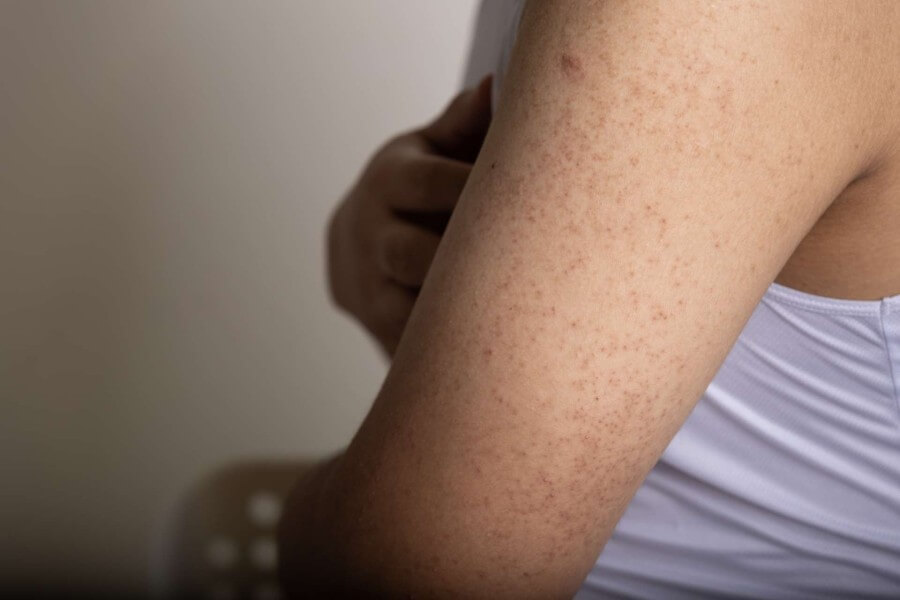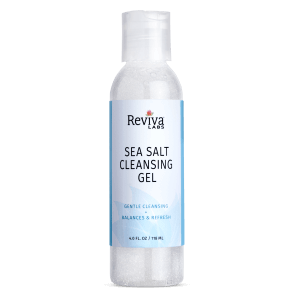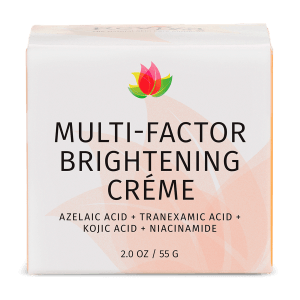Ingredients, Natural, Reviva Labs, Skin Care
Topical Solutions for Keratosis Pilaris
Keratosis Pilaris (KP) is a common, harmless skin condition that affects millions of people worldwide. It is characterized by small, rough bumps on the skin, typically found on the outer, upper arms, thighs, buttocks, and sometimes the cheeks. KP is sometimes referred to as strawberry skin or chicken skin. Although KP is not curable, various topical solutions can help manage its symptoms and improve the appearance of the affected skin. By exploring the causes, symptoms, and treatments for Keratosis Pilaris we can highlight the most effective topical solutions available.
What is Keratosis Pilaris?
Keratosis Pilaris occurs when dead skin cells and a protein called keratin build up, blocking the hair follicles. This buildup results in the formation of small, red or white bumps in patches on the skin. Often referred to as “chicken skin” or “strawberry skin” due to its appearance, KP is completely harmless and can affect people of all ages, although it is more common among teenagers and adults with lighter skin tones.
Causes of Keratosis Pilaris
The exact cause of Keratosis Pilaris is unknown, but genetics seem to play a significant role in its development. Individuals with a family history of KP or those with fair skin are more likely to experience this condition. Additionally, it is more common among people who are prone to eczema or have a history of asthma, hay fever, or other allergies. KP usually appears during childhood and may start to disappear in the mid-30s for some people.
Symptoms of Keratosis Pilaris
The primary symptom of Keratosis Pilaris is the presence of small, rough bumps on the skin. These bumps can be red, white, or discolored and are typically not painful or itchy. However, KP can sometimes cause mild itching, especially during the winter months when the skin is drier due to lower humidity levels. It is important to note that many other skin conditions can appear similar to KP, so a proper evaluation by a dermatologist is necessary for accurate diagnosis.
How to Treat Keratosis Pilaris
Although Keratosis Pilaris cannot be cured, various treatments can help manage its symptoms and improve the appearance of the affected skin. The most effective approach involves a combination of exfoliation and moisturization. By using topical solutions that contain specific ingredients, such as alpha hydroxy acids, beta hydroxy acids, and urea, you can achieve smoother, softer skin with reduced redness and bumpiness.
Exfoliating Treatments
Exfoliation is an essential step in treating Keratosis Pilaris, as it helps remove dead skin cells and unclog hair follicles. There are two primary types of exfoliants: physical and chemical. Physical exfoliants, such as scrubs and loofahs, can be used to gently remove dead skin cells from the skin’s surface. However, it is crucial not to over-exfoliate or use harsh scrubs, as this can worsen the condition.
Chemical exfoliants, on the other hand, work by dissolving dead skin cells and promoting skin cell turnover. The most effective chemical exfoliants for KP are alpha hydroxy acids (AHAs), such as lactic acid and glycolic acid, and beta hydroxy acids (BHAs), like salicylic acid. Urea is another useful ingredient that provides both exfoliating and moisturizing benefits. Some of Reviva’s customers have used our Glycolic Acid Cleanser on their affected areas with good results. Recently, we heard someone is using our Multi-Factor Brightening Crème on their arms to treat their KP.
Moisturizing Treatments
Moisturization is equally important in managing Keratosis Pilaris, as it helps to soothe and hydrate the skin. Look for products that contain ingredients like lanolin, petroleum jelly, glycerin, ceramides, and niacinamide, as these help to lock in moisture and protect the skin’s natural barrier. Thicker moisturizers, such as creams and ointments, are generally more effective than lotions for treating KP.
Topical Creams and Lotions
A variety of topical creams and lotions can help reduce the appearance of Keratosis Pilaris. These products typically contain a combination of exfoliating and moisturizing ingredients to provide the most effective treatment. Reviva’s Elastin Collagen Body Lotion is moisturizing and soothing.
Topical Body Washes
Using a body wash that contains exfoliating and moisturizing ingredients can also help manage Keratosis Pilaris. Reviva’s Sea Salt Cleansing Gel is a good solution.
Home Remedies
If you prefer trying at-home treatments before consulting a dermatologist, consider using natural remedies like coconut oil, which has anti-inflammatory and moisturizing properties. Mixing coconut oil with sugar can create a gentle exfoliating scrub. Additionally, using a humidifier in your home can help maintain moisture levels in the air, preventing skin dryness and worsening of KP symptoms.
Tips for Managing Keratosis Pilaris
Here are some helpful tips for managing Keratosis Pilaris:
- Use warm water and limit bath time to 10 minutes or less.
- Avoid harsh, drying soaps and vigorous scrubbing.
- Apply a moisturizer while the skin is still damp after showering.
- Reapply moisturizer to affected areas several times a day.
- Use a humidifier to maintain moisture levels in your home.
- Avoid tight clothing that can cause friction on affected skin.
Preparing for a Dermatologist Appointment
If you decide to consult a dermatologist regarding your Keratosis Pilaris, it is helpful to prepare a list of questions to ask during your appointment. Some questions to consider include:
- What is causing my symptoms?
- Are there other possible causes for my symptoms?
- Is this condition short-lived, or will it last a long time?
- What is the best course of action?
- Are there alternatives to the primary approach you’re suggesting?
- Is there a generic alternative to the medication you’re prescribing?
KP Help is Out There
Keratosis Pilaris is a common, harmless skin condition that can cause small, rough bumps on the skin. While it cannot be cured, various topical solutions can help manage its symptoms and improve the appearance of affected skin. By incorporating a combination of exfoliation and moisturization into your skincare routine, you can achieve smoother, softer skin with reduced redness and bumpiness.











